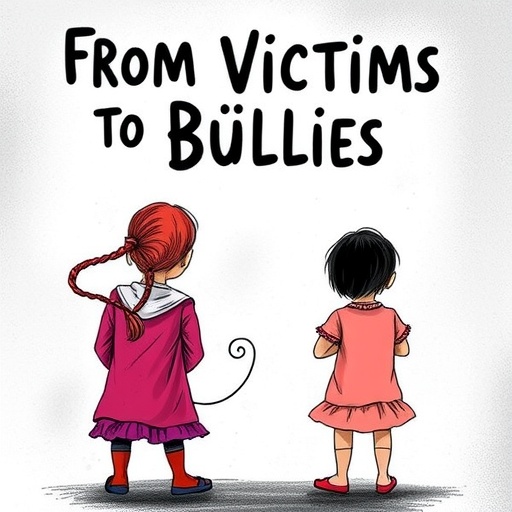In the intricate web of human development, childhood experiences within the family setting serve as a foundational cornerstone. Recent research spearheaded by Zhang, X., Zhang, Z., Zhao, Y., and colleagues delves deeply into how early-life abuse within families can ripple outwards, culminating in adolescent peer bullying behaviors. This groundbreaking study, published in BMC Psychology, elucidates the transformation of victims into aggressors and offers vital insights that could reshape preventative strategies in educational and psychological domains.
The research adopts a longitudinal approach, meticulously tracing the developmental trajectories of children exposed to various forms of family abuse—including physical, emotional, and neglectful behaviors. The premise is built on the hypothesis that early adverse experiences significantly heighten the likelihood of these individuals engaging in bullying during adolescence. Through extensive psychological assessments and behavioral monitoring, the research team presents compelling evidence that challenges prior assumptions which often viewed bullying solely as a peer-group dynamic.
At its core, the study investigates the neuropsychological and social mechanisms that facilitate this transformation from victimhood to perpetration. It underscores how persistent exposure to family abuse disrupts normal emotional regulation and stress-response systems. These disruptions predispose children to adopt aggressive coping strategies that manifest as bullying peers. The research spotlights critical alterations in brain regions such as the amygdala and prefrontal cortex, which are responsible for threat detection, impulse control, and empathy—functions essential for healthy social interactions.
One aspect that makes this research particularly poignant is its nuanced examination of the types of family abuse and their differential impact. Whereas physical abuse is commonly recognized as harmful, the study reveals that emotional neglect and psychological maltreatment may hold equally potent, if not more insidious, effects. These forms of abuse degrade a child’s self-worth and social skills, effectively prime them for social retaliation in school environments, where they may feel compelled to reassert control through bullying.
The interplay between genetic predispositions and environmental stressors is also dissected with scientific rigor. The team references epigenetic frameworks that describe how environmental stress can modify gene expression, potentially rendering some children more vulnerable to aggressive behaviors. Understanding this biopsychosocial nexus presents a transformative opportunity for early detection. Clinicians and educators could identify at-risk youths before their victimization translates into aggression toward others.
Recognizing that bullying in adolescence is a multi-dimensional phenomenon, the study integrates social ecological models to place family abuse within a broader sociocultural context. Peer group acceptance, school climates, and community support systems are discussed as either mitigating or exacerbating factors. This holistic approach marks a shift away from reductionist perspectives, reinforcing that interventions must be comprehensive and cross-sectoral.
Methodologically, the research is robust, employing a mixed-method design that combines quantitative surveys with qualitative interviews. The quantitative data derive from standardized measures of abuse history, bullying frequency, and mental health indices. Qualitative narratives enrich the findings by illuminating lived experiences and the underlying motivations of those who bully peers after enduring abuse at home. This dual approach strengthens the validity and applicability of the conclusions.
Particularly alarming are the longitudinal analyses that link early abuse trauma with chronic bullying patterns through adolescence. The persistence of this aggression has knock-on effects on academic performance, social relationships, and mental health outcomes, including increased risks for anxiety, depression, and even suicidal ideation. These findings underscore the urgent need for systemic reforms in child welfare and educational policies aimed at early intervention.
The study’s implications extend beyond clinical and educational realms, challenging societal myths about bullying dynamics. By illustrating that aggressors can simultaneously be victims of family trauma, it calls for empathetic understanding rather than simplistic blame. Such insights could reshape public discourse and inform media portrayals about the roots of aggressive adolescent behaviors.
Importantly, the research highlights potential intervention pathways. Trauma-informed care, family therapy, and social-emotional learning programs are suggested as effective strategies to interrupt the cycle of abuse and bullying. Tailoring these interventions to address the specific trauma histories of youths is emphasized, moving beyond one-size-fits-all models.
Technological innovations in psychological assessment, such as biomarker analytics and neuroimaging, were deployed in the study to provide objective evidence of the neurobiological impact of abuse. These advanced tools offer exciting vistas for personalized treatment approaches and enhanced monitoring of at-risk children’s developmental progress.
The researchers caution that while the link between family abuse and bullying is strongly supported, causality is complex and influenced by numerous factors. They advocate for continued multidisciplinary research to unravel these complexities, including exploration of protective factors that foster resilience even in abuse-exposed youths.
The study represents a critical step forward in understanding how early adverse experiences can cast long shadows over social functioning. Its comprehensive framework offers a new lens for educators, clinicians, and policymakers to recognize and address the origins of bullying—potentially curbing the perpetuation of violence and emotional suffering within adolescent populations.
Overall, this research opens a hopeful chapter in mental health and juvenile behavior studies by shifting the narrative from vilification to understanding, emphasizing that behind many aggressors lies a history of victimization. The transformative potential of this paradigm is immense, promising better prevention, more nuanced support, and a more compassionate society.
Subject of Research: The psychological and behavioral link between childhood family abuse and adolescent peer bullying.
Article Title: From Victims to Aggressors: The Link Between Childhood Family Abuse and Adolescent Peer Bullying.
Article References:
Zhang, X., Zhang, Z., Zhao, Y. et al. From victims to aggressors: the link between childhood family abuse and adolescent peer bullying. BMC Psychol 13, 1079 (2025). https://doi.org/10.1186/s40359-025-03407-3
Image Credits: AI Generated




